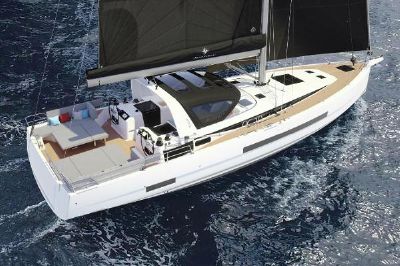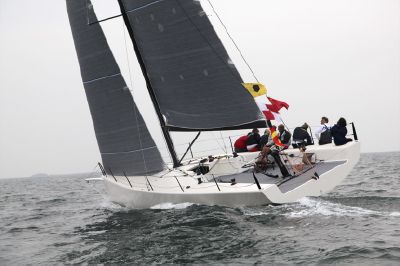Cruiser/Racers
- Activities: Overnight Cruising and Racing
- Length Range: 35 - 50 ft.
- Average price: $238,000
- 2-3 cabins
Modern sailors sneer at “racer/cruiser” as an overused marketing term, designed to make any race boat appeal to “the wives” or any cruising boat appeal to a buyer’s competitive instincts. And looking at today’s specialized craft, it’s hard even for me to remember back to when most owners and their crew slept aboard the boat during race events—on full-length, comfortable, foam-cushioned bunks.
Specialization is the natural result of evolution, and sailboats have certainly evolved over the past four decades. But many sailors want to race and cruise (and some aren’t quite sure yet which they’d prefer), so builders are still trying to meet that need. There’s also something quite special about a boat that can bring home the silver and then, only a few days later, provide a comfortable home for a long-distance cruise. For all these reasons, the racer/cruiser has survived the age of specialization—and the term is not as unspecialized as it might sound. Let’s delve a little deeper into what really defines this type of boat.
Most racer/cruisers are between 35' and 50' in overall length. Smaller boats will usually be too cramped for a comfortable cruise, and boats over 50' are generally built for either racing or cruising; trying to make them appropriate for both would be too expensive. The Dehler 46 is a good example of a racer/cruiser at the larger end of the range. At the bottom end, the Dufour 36P “might just be the boat that brings credibility back" to the term racer/cruiser.
On Deck
Racer/cruisers are a collection of compromises. In a few areas, priorities peacefully coexist; for example, the deck should be easy to get around in either mode. And most cruising amenities like dodgers, biminis, and cockpit tables can be removed, so they won’t interfere with race-pace boathandling and maneuvers. Other areas will require hard choices. With a little planning, it is possible to maximize the crossover potential. Here are some suggestions.
The standing rigging should be high-tech enough to be low-stretch and low-windage, but also have enough margin of safety to be worry-free when shorthanded crews are caught in an unexpected blow. Sticking to a middle-of-the-road rigging package will also save money, since specialized racing kits are more expensive.
The rest of the rigging and deck layout should allow for efficient sail changes, but not be too complicated or expensive to maintain or replace. Doubling up on spinnaker and jib halyards is a win in either cruising or racing mode; sail changes will be easier when racing, and the extras can serve as backup while cruising. Leading those halyards aft to the cockpit, though, is really only good for cruising. Racing sailors will prefer the speed and reduced friction of “jumping” a halyard at the mast.
Fuel or Not?
The hardest choice to make will be the roller furling jib. Most cruisers consider furlers a must since they make reefing and sail stowage so much easier. Racing sailors cringe at the shape of a furling jib, never mind the weight and windage and basic obstacle of that furling drum right in the bow. Harken and Facnor both offer a removable furler drum option, but that can be a pricey solution that doesn’t dramatically improve sail shape. The best approach is to choose a mode and live with it, especially for the first few years of boat ownership. It is possible to race with a furling drum in place, just as it’s possible to cruise without the convenience of a roller furler.
Sails
Back in the '70s, we could get away with using the same basic sail inventory for both cruising and racing—though even our family crew had a couple of specialty racing sails. Today, any competition more serious than the Wednesday night beer can series will require a separate inventory. Modern sails are simply too specialized (and too expensive) to cover both modes. Racing sails cost more, and they are less durable and harder to handle. Cruising sails will sacrifice a little speed for a longer lifespan and easier handling.
Down Below
Once we go belowdecks, the wish lists for racing and cruising diverge completely. A well-appointed cabin (enclosed head, comfortable bunks, galley, chart table) is a necessity for most cruisers. For any kind of serious racing, this “furniture” (a term used with a sneer by racing sailors) becomes a worrisome obstacle. Dragging sails across bunk cushions and varnished grabrails is likely to add water and scratches to both. Open acreage below also makes it easier for the poor sewer rat to repack all those racing spinnakers.
Any boat marketed as a racer/cruiser will have a few bunks, a basic galley, and a head with a curtain or door to wall it off from the rest of the cabin. Beyond that, it’s easy to tell how close to the cruising end of the spectrum a specific boat model is designed to be by how much furniture (and varnish) there is below. Hatches are one place where compromise is not needed; big enough for spinnaker sets and douses is also big enough for adequate cruising ventilation.
Ports, however, are not useful for racing—and the opening ones add weight. Being able to see out is simply not a requirement for racing sailors, since the sewer rat is not the one making tactical calls. Meanwhile, hanging on the hook in some beautiful harbor without ports is like going on a beach vacation and never leaving a windowless hotel room. Even ports above eye height add light and the illusion of space, a very welcome addition on rainy days when the crew may be stuck below.
Galley
Meals for day races will most likely be brought on board ready to eat. Distance racers rely on freeze-dried food, since the only preparation it requires is the ability to boil water. So any basic galley will be perfectly adequate for racing.
For cruisers, one of life’s many onboard pleasures is a hot meal. There is nothing—absolutely nothing—that smells as good as a simple dinner cooking on the stove while hanging on the hook in some remote harbor. Cruising galleys will need more burners, more counter space, a larger icebox/fridge, and more lockers for pots, pans, and food.
Racer/cruisers aren’t for everyone, and many builders try to pack too much into too small a boat in an attempt to widen its appeal. Consignment shops and yard sales are filled with gear removed from new boats bought for two purposes—and then only used for one. For anyone who wants to do some racing and some cruising, or for first-time buyers who aren’t sure which they will prefer, a racer/cruiser may be the perfect addition to the family.
Cruiser/Racers for Sale
Expert Articles about Cruiser/Racers
Featured Brands
All of our Brands for Cruiser/Racers
- Archambault
- Arcona
- Bavaria
- Beneteau
- Beneteau America
- C&C
- Catalina
- Classic
- Columbia
- Contest
- Custom
- Dehler
- Delphia
- Dufour
- Farr
- Gib'Sea
- Grand Soleil
- Hallberg-Rassy
- Hanse
- Hunter
- J Boats
- Jeanneau
- Maxi
- Mirage
- Moody
- Nautor Swan
- One Design
- Pacific Seacraft
- Sailboat
- Sly
- Solaris
- Sydney
- Tartan
- Wauquiez
- X-Yachts











